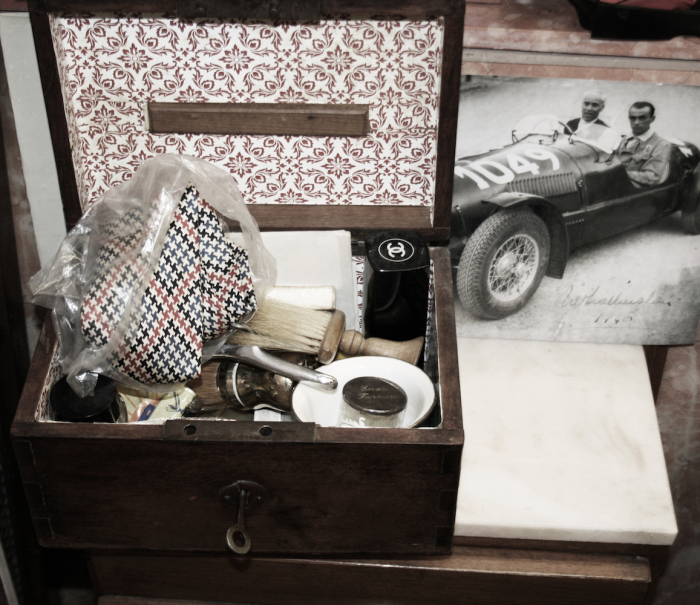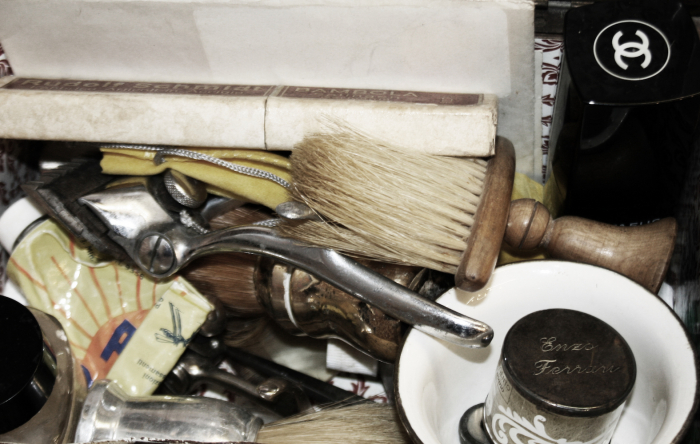MASSIMO & STEFANO
by Luca Giangrandi
Our neighbours in the city centre of Modena, Stefano and Massimo made the story of barbering in town, even if only few people still remember it. Ever since Massimo’s uncle, Antonio D’Elia, opened the shop in 1938, their clientele has been including prominent figures of the Modenese high society, the like of Enzo Ferrari. Stefano, one of the two owners that we have met on a Monday morning – iconoclasm of a barber’s rest – tells us about Ferrari: “Like many others, he used to come here every day to be shaved. It was a rite. He showed up every morning at ten o’clock. After paying a visit to his son Dino at the cemetery. Then he said ‘A vag a butega…’ (I go to the workshop) and went to his factory in Maranello. It was a sign of false modesty, of course, to call it bottega…”
Paradigmatic of a vanished time, the story of Stefano is much more interesting than that of Enzo Ferrari. Grown up amidst shaving creams since he was a child, he tells us: “I come from Apulia. I have started working as a barber at the age of six. I started applying lather. They put me on a stool and I worked. Things that now would send you to jail within three days. I went to the shop especially to avoid staying in the streets, where you were likely to have unpleasant encounters, even at such a young age. It was a sort of after-school activity. Then I started to shave tonsures for priests, and continued until the age of eight. Then I started to use the razor – some little cuts, it can happen, you know. They used to send you the village idiot, who served as a kind of guinea pig – he didn’t pay and you shaved him.
Then I started shaving sideburns, levelling off moustaches, I was ten years old. To sum it up: I was not yet fourteen, when I arrived in Modena. I moved here alone. I told the first barber I met: ‘I am a barber, do you need help?’ ‘Of course, come in!’ They made me wear a white coat bigger than me and I started working. I thought I already knew everything, but I didn’t know anything”.
14 years old, alone, 720 km away from home. And today we complain if we have to get on a train to go to work. Indeed, lazy generations, absent-minded and soaked in indolence. Stefano does not spare us: “What I did is unconceivable for young people today. Because they are all cuckoos. People are rarely devoted to their job. Maybe it depends on the lack of necessity. Maybe the crisis will change it all.” His story goes on: “When I was seventeen, I passed by here and met Massimo D’Elia, who is my business partner now and who was already working here with his uncle. Being acquainted with Massimo, I got a job at the shop. When his uncle retired we took over the shop. I have been here every day since then, times have changed but we have always stayed the same”. Regardless of the crisis and of old loyal customers, the beard’s fashion has also showed up at the shop’s door. “There are boys that court you because they want to be shaved.
But I think you can’t ask too much for a shaving, which furthermore takes you a lot of time. It’s an art form and as such it requires special care”. But what tools are used today for beard grooming? What has changed?
“Now there are disposable razors with the blade, because the problem with the old ones was that they could bring diseases. Once, in a shop like this, each loyal customer had his own tools. They were kept in a sort of niche, a small box with the name of the customer: there were his razor, his creams and his soap. This was a prominent shop and our customers could afford all this, and also to have a clean towel for hot towel shaves. In the other shop where I had worked, instead, a single towel was used for up to seven or eight different clients. Today customers come here once a week, in order to enjoy a brief moment of relax. We still perform all the rituals required by the shaving ceremony, but it is no longer the same thing”.
MASSIMO & STEFANO
Corso Canalgrande, 73
Modena

